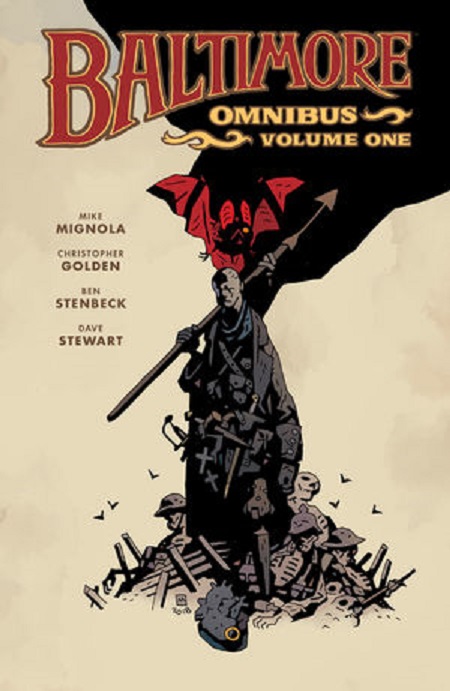Comic Book Review: Baltimore Omnibus Volume One written by Mike Mignola and Christopher Golden, art by Ben Stenbeck
Lord Henry Baltimore was once a happily married man, wealthy enough and fairly privileged. But then World War One happened, and his country called. But this was not quite the WWI you may have read about in history books, horrible as that was. On this Earth, vampires haunted the trenches, feeding on the dead and dying. Baltimore happened to be more alive than he looked, despite losing a leg, and slashed an attacking vampire across the eye with his bayonet. The vampire, Haigus, swore vengeance.

While Baltimore recovered in hospital, a plague began to spread across Europe, starting with the battlefields. Even more deadly than our world’s influenza, it killed so many people that the Great War just fizzled out. The surviving soldiers were needed in their homelands to care for the sick or try to carry on civilization. Even Lord Baltimore was released, once he could move on his new wooden leg.
He returned home to find that Haigus had arrived first and murdered his entire family, turning them into vampires. Lord Baltimore was forced to destroy all of them, including his beloved wife. Naturally he vows vengeance on Haigus, and the first volume of this series is about him pursuing that goal.
This horror comics series was first an idea by Mike Mignola (Hellboy) inspired by Hans Christian Andersen’s The Steadfast Tin Soldier and Captain Ahab from Moby Dick, plus a terrible horror film he does not name. This was turned into a novel by Christopher Golden, and they then adapted it into a comic book format, choosing Ben Stenbeck to do most of the art. (Mr. Mignola contributed character designs and covers.)
There are several major plot arcs in this volume, and a few standalone stories.
“The Plague Ships” takes place on the coast of France. After Baltimore frees a fishing village of most of their vampires, he is imprisoned by the locals. They fear that he too has been contaminated by evil and are calling in Father Duvic of the Inquisition to judge if this is the case.
Baltimore is sprung by Vanessa, the granddaughter of the local witch. She can get him a ship to his next destination, but only if he takes her with him. Baltimore knows anyone with him is marked for death, but has little choice. To no one’s surprise except Vanessa’s, the ship is wrecked and she and Baltimore wash up at Furiani, once a German submarine base. It turns out there are other horrors in the world besides vampires.
“The Curse Bells” takes us to Switzerland and a convent of vampire nuns. In a bit of a twist, Haigus has been taken captive so that his blood can be used by a madman to bring Madame Blavatsky back from the dead. Seems that madman has a plan that requires the undead spiritualist to use her powers on his behalf to ease his path to world conquest. Neither Haigus nor Blavatsky is enamored of the madman, or each other, but they find the plan somewhat amusing.
Baltimore and a journalist named Hodge investigate, and Baltimore is forced to put an end to the madman’s plans, which means Haigus manages to escape again. The madman’s identity, while never spoken, is easy to guess.
“The Inquistor” and “The Infernal Train” feed into each other. Father Duvic has been obsessively hunting Lord Baltimore all this time, torturing and killing witnesses in an attempt to track the vampire hunter. He catches up to Hodge, who manages to point out some cognitive dissonance on Duvic’s part, then arranges for the two hunters to meet in Budapest. In Budapest, Baltimore is investigating an odd train engine, which turns out to run on vampires. It’s a plan by one of Haigus’ rivals to please the Red King (the progenitor of monsters) and secure her a position of power in the new order. Baltimore must battle Duvic (who turns out to have secrets of his own) while trying to stop the train.
“Chapel of Bones” caps the volume with a seemingly final confrontation between Lord Baltimore and Haigus. The vampire has captured Baltimore’s few remaining living friends and uses them as bait for a trap. Haigus has grown weary of the chase and realizes it was a mistake to turn Baltimore into an obsessive hunter and doom them to a cycle of revenge. But he still blames Baltimore for wounding him, “awakening” Haigus from his previous bestial state to a thinking and feeling being, which did the same for the other vampires. (This is a little unfair. Statistically, someone, somewhere, was going to wound a vampire without killing it.)
With Haigus now apparently gone, Baltimore realizes that he is no longer human himself, and that he’s attracted the attention of the Red King directly, which can’t be good for him or the world.
The book concludes with an excellent art gallery of covers, layouts and character sketches.
The premise is interesting, the art outstanding, and I like many of the monster designs. Lord Baltimore isn’t a particularly likable character, but he doesn’t have to be for this kind of story. In this first volume, he’s obsessed with his one target, killing other monsters primarily as a means to that goal or in self-defense. He resents every time his conscience requires him to put off his primary mission to deal with other people’s problems. Still, he does have that conscience, which is enough to make him a watchable protagonist.
Content note: lots of gory violence, often lethal. Death of children. Body horror. Torture. Some rough language.
Lord Baltimore’s world is a bleak one, rapidly falling into darkness and terror. Small victories are won, but the larger picture appears to be doom. Most recommended to horror fans.

